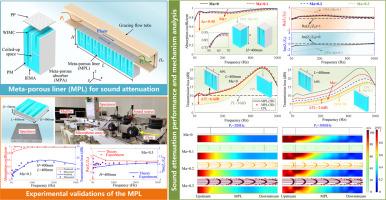掠流作用下超低超宽带介孔衬板
IF 9.4
1区 工程技术
Q1 ENGINEERING, MECHANICAL
International Journal of Mechanical Sciences
Pub Date : 2025-09-17
DOI:10.1016/j.ijmecsci.2025.110849
引用次数: 0
摘要
声学衬垫在噪声控制领域受到越来越多的关注。然而,设计一种简单的元衬里(包含几个亚单元)来实现宽速度范围放牧流下的宽带低频声衰减仍然是一个挑战。这项工作提出了一种由穿孔板和盘绕空间组成的超多孔衬垫(MPL),其中填充了含有楔形阻抗调制通道的多孔材料。提出了一种考虑MPL流声耦合效应的声阻抗预测方法。此外,利用解析预测的声阻抗,建立了预测掠流作用下MPL吸声性能的有限元模型。然后,对MPL的吸声性能和机理进行了研究。较强的阻抗调制能力和掠流下的声稳定性共同决定了MPL在大转速范围掠流下的高效消声。通过流管实验验证了该建模方法的有效性和声衰减性能。制作并测量了厚度为400mm的MPL试样。在马赫数为0-0.3的掠流条件下,在50-3000 Hz的超低超宽带频率范围内实现高效的声衰减。随后,分析了几何参数和材料参数对声学特性的影响。为了满足不同的消声需求,设计了一系列厚度从50mm到400mm不等的MPLs。它们可以在覆盖频率低于500hz甚至低于100hz的超宽带频率范围内的宽速度范围放牧流下实现有效的声衰减。由于所提出的MPLs结构简单,但具有超低、超宽带的消声性能,在放牧流噪声控制工程中具有广阔的应用前景。本文章由计算机程序翻译,如有差异,请以英文原文为准。

Ultra-low and ultra-broadband meta-porous liner under grazing flow
Acoustic meta-liners have received increasing attention in the field of noise control. However, it is still a challenge to design a simple meta-liner (with a few subunits) to achieve broadband low-frequency sound attenuation under wide-speed range grazing flow. This work proposes a type of meta-porous liner (MPL) consisting of perforated panels and coiled-up spaces filled with porous material containing wedge-like impedance modulation channels. An analytical method for predicting acoustic impedance considering fluid-acoustic coupling effects of the MPL is developed. Besides, by employing the analytically predicted acoustic impedance, a finite element model for predicting sound attenuation performance of the MPL under grazing flow is established. Then, sound attenuation performance and mechanism of the MPL are investigated. The strong impedance modulation capability and the acoustic stability under grazing flow together contribute to the efficient sound attenuation of the MPL under wide-speed range grazing flow. A flow tube experiment is conducted to verify the effectiveness of the modeling method and the sound attenuation performance. An MPL specimen (400 mm thickness) is fabricated and measured. It can achieve efficient sound attenuation in the ultra-low and ultra-broadband frequency range of 50‒3000 Hz under grazing flow within Mach number of 0‒0.3. Subsequently, the effects of geometrical and material parameters on acoustic characteristics are analyzed. To meet diverse sound attenuation requirements, a series of MPLs with various thicknesses ranging from 50 mm to 400 mm are designed. They can achieve efficient sound attenuation under wide-speed range grazing flow over ultra-broadband frequency range covering frequencies below 500 Hz or even below 100 Hz. Since the proposed MPLs have simple constructions yet ultra-low and ultra-broadband sound attenuation performance, they have wide application prospects in noise control engineering under grazing flow.
求助全文
通过发布文献求助,成功后即可免费获取论文全文。
去求助
来源期刊

International Journal of Mechanical Sciences
工程技术-工程:机械
CiteScore
12.80
自引率
17.80%
发文量
769
审稿时长
19 days
期刊介绍:
The International Journal of Mechanical Sciences (IJMS) serves as a global platform for the publication and dissemination of original research that contributes to a deeper scientific understanding of the fundamental disciplines within mechanical, civil, and material engineering.
The primary focus of IJMS is to showcase innovative and ground-breaking work that utilizes analytical and computational modeling techniques, such as Finite Element Method (FEM), Boundary Element Method (BEM), and mesh-free methods, among others. These modeling methods are applied to diverse fields including rigid-body mechanics (e.g., dynamics, vibration, stability), structural mechanics, metal forming, advanced materials (e.g., metals, composites, cellular, smart) behavior and applications, impact mechanics, strain localization, and other nonlinear effects (e.g., large deflections, plasticity, fracture).
Additionally, IJMS covers the realms of fluid mechanics (both external and internal flows), tribology, thermodynamics, and materials processing. These subjects collectively form the core of the journal's content.
In summary, IJMS provides a prestigious platform for researchers to present their original contributions, shedding light on analytical and computational modeling methods in various areas of mechanical engineering, as well as exploring the behavior and application of advanced materials, fluid mechanics, thermodynamics, and materials processing.
 求助内容:
求助内容: 应助结果提醒方式:
应助结果提醒方式:


